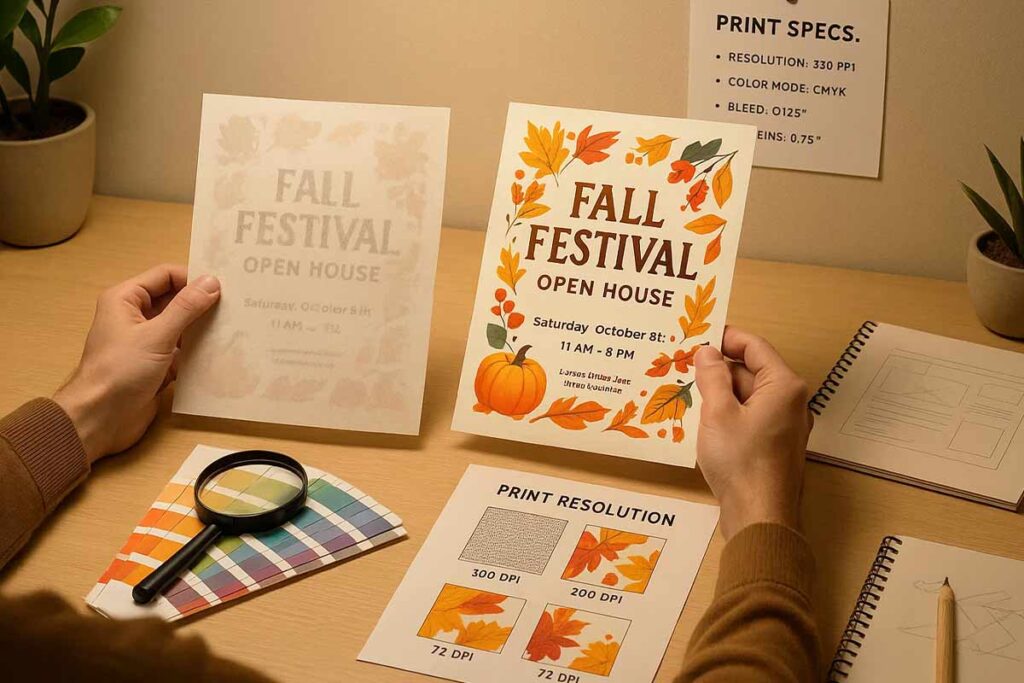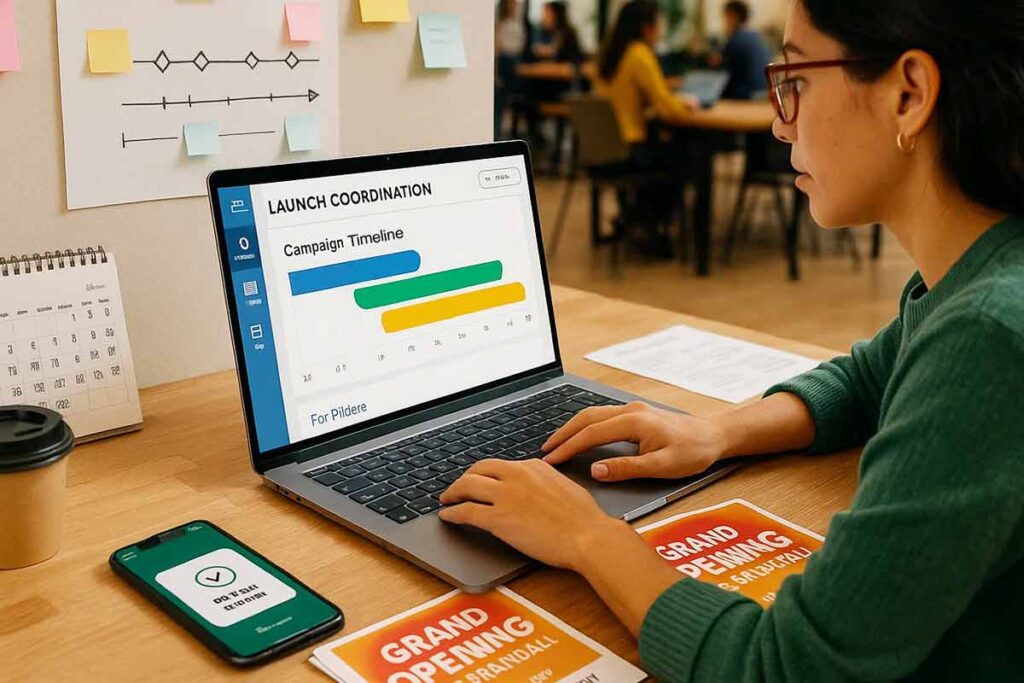A single flyer error costs small businesses $200–500 in reprints, derailing campaigns and damaging credibility. The pre-launch phase prevents these costly mistakes through systematic verification that catches 95% of errors before publication.
A flyer design checklist empowers business owners to create impactful marketing materials by verifying design elements, content accuracy, technical specifications, and legal compliance. This systematic approach prevents 73% of common errors while ensuring clear messaging, strong visual hierarchy, and effective calls-to-action. Modern flyer makers streamline the process, helping you create flyers, but verification remains essential for professional results.
The 48-hour pre-launch window catches typos, incorrect dates, and misaligned visuals that undermine campaigns. Unverified flyers risk missed opportunities and reduced customer trust. A 6-stage verification process covering design, content, technical specs, legal compliance, quality assurance, and launch coordination protects your reputation and budget. Allocating 2–4 hours for multi-reviewer checks ensures professional flyers that maximize campaign success.
Design and Visual Elements Verification
A successful flyer template design hinges on the careful balance between visual appeal and functional communication, where every element serves a purpose in capturing your audience’s attention. When you create a flyer, the design and visual components become the foundation that determines whether your marketing materials will stand out in a crowded marketplace or get lost among countless promotional flyers. This section provides a comprehensive flyer design checklist covering essential visual elements including typography, color schemes, imagery, layout principles, and brand consistency that transform ordinary marketing collateral into compelling promotional design pieces. Whether you’re using a flyer maker tool or working with a custom flyer designer, understanding these core design principles ensures your property marketing materials effectively communicate your message while maintaining professional standards. From digital flyer creation to print-ready formats, mastering these visual verification techniques will elevate your flyer design ideas from concept to conversion-focused marketing tools.
Layout and Composition Quality Control
Effective flyer design hinges on meticulous layout and composition verification. Your design flyers online workflow must include systematic quality control checks to ensure professional marketing materials that capture attention and drive results.
Begin by examining visual hierarchy and balance. Elements should guide the reader’s eye naturally through your promotional flyers, with proper spacing between text blocks and images. Check alignment consistency across all design elements, ensuring headers, body text, and call-to-action buttons maintain uniform positioning.
Begin by examining visual hierarchy and balance. Elements should guide the reader’s eye naturally through your promotional flyers, with proper spacing between text blocks and images. Create a visual hierarchy: a strong headline, paired with a high quality image and short supporting text if necessary (Northwestern University, 2025).1 Check alignment consistency across all design elements, ensuring headers, body text, and call-to-action buttons maintain uniform positioning.
When you create a flyer online, conduct final reviews on multiple devices to identify potential display issues. Check that your custom flyer maker output maintains quality across print and digital formats. Professional flyer design ideas incorporate these quality control measures to produce compelling promotional design that effectively communicates your message and strengthens your property marketing efforts.
Read More: Flyer Size Guide 2025 (Latest)
Color and Print Preparation Verification
Before finalizing your flyer design, thorough color and print preparation verification ensures professional marketing materials that represent your brand effectively. This critical stage prevents costly reprinting and maintains design integrity across different output formats.
Color Mode and Profile Verification
- Confirm CMYK color mode for print materials and RGB for digital flyer maker applications
- Verify color profiles match intended output devices and printing specifications
- Check color consistency across different viewing conditions and paper types
- Test promotional flyers on target printers to identify potential color shifts
Print Specifications Review
- Validate resolution requirements (minimum 300 DPI for print, 72 DPI for digital)
- Confirm bleed areas extend 0.125 inches beyond trim marks for professional results
- Review paper stock compatibility with ink coverage and design elements
- Verify cut marks and fold lines align with printer capabilities
Output Testing Protocol
- Create test prints using actual paper stock and printing conditions
- Compare digital proofs with physical samples under various lighting conditions
- Document any necessary adjustments to your flyer design checklist for future reference
Image Quality and Resolution Standards
Professional flyer design demands high-resolution images that maintain clarity across all marketing materials. When you create a flyer, ensure all images meet minimum 300 DPI standards for print applications and 72 DPI for digital distribution. Poor image quality undermines your promotional design credibility and reduces marketing collateral effectiveness.
Key resolution requirements include using vector graphics for logos and text elements, maintaining aspect ratios to prevent distortion, and selecting appropriate file formats. JPEG works best for photographs, while PNG supports transparent backgrounds essential for layered design elements.
Your flyer design checklist should verify image sharpness, color accuracy, and proper compression ratios. Blurry or pixelated visuals signal unprofessional marketing materials that damage brand perception. Design templates should accommodate various image sizes while preserving quality standards.

Professional flyer creators prioritize image optimization to ensure promotional flyers maintain visual impact whether viewed digitally or printed. Quality control prevents costly reprints and enhances overall design effectiveness.
Typography and Text Element Review
Typography forms the backbone of effective flyer design, directly impacting readability and professional appeal. Your flyer design checklist should prioritize font consistency, hierarchy, and legibility across all marketing materials.
- Font Selection: Limit to 2-3 complementary typefaces maximum. Sans-serif fonts work best for headers, while serif fonts enhance body text readability in promotional flyers.
- Text Hierarchy: Establish clear visual priority using font sizes, weights, and spacing. Headlines should dominate, followed by subheadings and body content in your flyer design.
- Readability Assessment: Ensure 12pt minimum for body text and adequate contrast ratios. Test your design flyers online across different devices and lighting conditions.
- Alignment and Spacing: Maintain consistent margins, line spacing, and text alignment throughout your marketing collateral. Poor spacing undermines professional flyer maker results.
Proper typography transforms basic promotional design into compelling marketing materials that effectively communicate your message and maintain brand consistency across all flyer design ideas.
Read More: Flyer Design Etiquette: Fonts, Texts, and Messaging Guide
Content Accuracy and Information Verification
In today’s competitive marketplace, accuracy and credibility form the foundation of effective promotional materials, particularly when businesses create a flyer to showcase their services or products. Whether you’re using a flyer maker or working with a custom flyer maker to design flyers online, the information presented must be meticulously verified to maintain your brand’s reputation and legal compliance. This section examines the critical importance of fact-checking in flyer design, exploring how proper information verification protects your business while enhancing the effectiveness of your marketing collateral. From property marketing campaigns to general promotional flyers, we’ll cover essential verification protocols, source validation techniques, and quality assurance processes that professional flyer designers implement. Understanding these accuracy standards ensures that whether you make your own flyer or utilize a digital flyer maker, your marketing materials maintain the highest standards of reliability and trustworthiness that today’s discerning audiences expect.
Core Information Verification Framework
Accurate information forms the foundation of effective flyer design. A comprehensive flyer design checklist ensures all content undergoes systematic verification before publication. Educational research emphasizes that effective information evaluation requires assessing “Authority, Accuracy, Objectivity, Currency, and Coverage” (University of Alaska Fairbanks, 2024)2, principles that directly apply to marketing material verification processes.
- Source Authentication: Verify all facts, dates, contact information, and pricing details through primary sources
- Content Cross-Reference: Double-check promotional claims against current offerings and legal requirements
- Brand Consistency: Confirm logos, colors, and messaging align with established brand guidelines
- Proofreading Protocol: Review text for spelling, grammar, and formatting errors across all marketing materials
Legal and Compliance Information Review
Ensure your flyer design complies with legal requirements and industry standards. Professional flyer creators must verify copyright permissions for images, fonts, and content before finalizing marketing materials. The Federal Trade Commission mandates that “claims in advertisements must be truthful, cannot be deceptive or unfair, and must be evidence-based” (FTC, 2024)3, making accuracy verification a legal requirement rather than just best practice. Review trademark usage, privacy regulations, and advertising standards specific to your industry.
- Verify all visual elements have proper licensing or are royalty-free, following U.S. Copyright Office guidelines that protect “original works of authorship as soon as an author fixes the work in a tangible form of expression” (U.S. Copyright Office, 2024)4
- Check text content for accuracy and legal compliance
- Confirm contact information meets local business requirements
- Validate promotional claims and disclaimers
Proper compliance protects your brand and ensures effective promotional design campaigns.
Pricing and Offer Verification
Accurate pricing information builds trust in your flyer design and prevents legal complications. Marketing materials with incorrect offers can damage credibility and create customer disputes.
Essential verification steps:
- Cross-check all prices, discounts, and promotional terms against current databases
- Verify expiration dates and availability restrictions for special offers
- Confirm currency symbols, decimal points, and formatting consistency
- Review terms and conditions for promotional flyers and marketing collateral
Professional flyer creators always double-check pricing accuracy before finalizing design templates for distribution.
Flyer Type-Specific Content Verification
Different flyer design types require specialized content verification approaches. Event flyers need accurate dates, venue details, and contact information, while promotional flyers must verify pricing, terms, and legal disclaimers. Real estate marketing materials require property details, licensing information, and compliance verification.
Business promotional design templates should confirm service descriptions, pricing validity, and brand consistency. Digital flyer maker tools often include built-in verification features for common flyer design mistakes.
Promotional Flyer
Professional flyer design requires strategic visual hierarchy and compelling messaging. Essential flyer design checklist includes clear headlines, contact information, and brand consistency. When you create a flyer, prioritize readability with adequate white space and legible fonts.
Modern flyer maker tools streamline the design process with customizable templates. Professional flyer creator platforms offer extensive marketing materials libraries. Design flyers online using proven layouts that convert viewers into customers.

Effective promotional design balances visual appeal with clear messaging for maximum impact.
Browse a curated selection of promotional flyer designs to market your event, product, or service with impact.
- Modern Orange Small Business Sale Event Flyer
- Small Business Saturday Shopping Event Flyer
- Small Candle Business Promotion Flyer
Event Flyer
Event flyer design requires strategic planning for maximum promotional impact. Professional flyer design combines compelling visuals with essential event information to create effective marketing materials.
Key elements include event title, date, time, venue, and contact details. Use bold typography for headlines and maintain consistent branding throughout your promotional flyers. Color schemes should align with event themes while ensuring readability.
Digital flyer maker tools streamline the design process, offering customizable templates for various event types. Effective flyer design balances visual appeal with clear information hierarchy.
Explore a curated collection of event flyer designs to promote your next gathering with style and clarity.
- Small Business Expo Conference Flyer
- Small Business Week Networking Event Flyer
- Small Business Trade Fair Event
Service Flyer
Professional flyer design requires strategic planning and precise execution. Effective promotional flyers combine compelling visuals with clear messaging to maximize marketing impact. When you create a flyer, consider your target audience and distribution channels.
Essential flyer design checklist includes brand consistency, readable fonts, and high-resolution images. Custom flyer maker tools streamline the design process, while flyer design ideas inspire creative solutions. Digital flyer maker platforms offer templates for various industries.
Quality marketing collateral drives customer engagement and business growth effectively.
Browse a curated selection of service flyer designs to effectively promote your business offerings.
- Professional Blue Business Consulting Services Flyer
- Small Business Growth Services Flyer
- Small Business Saturday Event Flyer
Fundraiser Flyer
Creating effective fundraiser flyers requires strategic flyer design that captures attention and drives donations. Essential marketing materials should include compelling headlines, clear donation information, and event details. Professional flyer design incorporates visual hierarchy, readable fonts, and engaging imagery that resonates with your cause.
Key elements for successful promotional flyers include contact information, payment methods, and compelling calls-to-action. Quality marketing collateral builds trust and credibility, encouraging community participation in your fundraising efforts while maintaining consistent brand messaging throughout all design templates.
Explore a curated collection of fundraiser flyer designs to promote your cause and boost community support.
- Corporate Charity Fundraiser Event Flyer
- Delicious Brown Bake Sale Fundraiser Flyer
- Community Muffin Sale Fundraiser Flyer
Grand Opening Flyer
Creating effective promotional flyers for grand openings requires strategic flyer design that captures attention and drives attendance. Essential marketing materials should highlight key event details, special offers, and business information using bold visuals and clear messaging.
- Design Elements: Eye-catching headers, vibrant colors, and professional imagery
- Content Requirements: Event date, location, special promotions, contact information
- Distribution Strategy: Digital flyer maker tools enable online sharing across social platforms and email campaigns
- Call-to-Action: Clear invitation encouraging immediate response
Browse a curated selection of grand opening flyer designs to generate buzz for your new business or location launch.
- Business Grand Opening Event Announcement Flyer
- Retail Store Grand Opening Flyer
- Store Grand Opening Announcement Flyer
Read More: 25+ Flyer Design Ideas & Examples for 2025
Technical Specifications and Print Readiness
Creating exceptional flyer design requires more than just attractive visuals—it demands meticulous attention to technical specifications that ensure your marketing materials translate perfectly from screen to print. This comprehensive section covers the essential technical requirements every flyer designer needs to master, from resolution and color profiles to bleed areas and file formats. Whether you’re using a flyer maker tool or working with a custom flyer design service, understanding these print readiness fundamentals will elevate your promotional flyers from amateur to professional quality. We’ll explore the critical specifications that separate successful marketing collateral from costly printing disasters, providing you with a complete flyer design checklist to ensure your property marketing materials, event promotions, and business advertisements achieve crisp, vibrant results every time. These technical foundations form the backbone of effective flyer creation, transforming your creative vision into tangible marketing materials that capture attention and drive results.
File Format and Quality Assurance
Professional flyer design requires meticulous attention to file specifications and quality standards. When you create a flyer, proper file formatting ensures optimal print reproduction and digital distribution across all marketing materials.
Essential file requirements include high-resolution PDF exports at 300 DPI minimum for promotional flyers, with CMYK color profiles for accurate print reproduction. Your flyer design checklist should verify bleed margins extend 0.125 inches beyond trim lines, preventing white edges during cutting. Vector elements maintain scalability across different marketing collateral sizes.
Quality assurance protocols involve comprehensive proofing workflows. Digital flyer makers must validate text legibility, color accuracy, and image sharpness before finalizing promotional design projects. Professional flyer creators implement multi-stage review processes, checking typography consistency and brand alignment throughout all marketing materials.

Establishing standardized quality benchmarks ensures consistent property marketing results across diverse promotional campaigns and design templates.
Printing Specifications and Vendor Coordination
Professional flyer design requires precise technical specifications to ensure quality output across different printing methods. When working with vendors, establish clear requirements for paper weight, color profiles, and finishing options before finalizing your promotional materials.
- Print-Ready File Formats: Deliver files in PDF/X-1a format with embedded fonts and CMYK color mode for commercial printing. Include bleed areas of 0.125 inches on all sides to prevent white edges after trimming.
- Resolution and Quality Standards: Maintain 300 DPI minimum for all images and graphics in your marketing collateral. Vector elements should scale without pixelation across different flyer sizes.
- Vendor Communication Protocol: Provide detailed print specifications including quantity, paper stock preferences, and delivery timelines. Request print proofs before full production runs to verify color accuracy and design alignment.
- Quality Control Checklist: Review final proofs for text readability, image sharpness, and proper color reproduction to ensure your design templates meet professional marketing standards.
Digital Distribution Optimization
Optimizing your flyer design for digital distribution requires specific technical considerations to ensure maximum reach and engagement across platforms. Professional flyers must maintain visual integrity whether shared via email, social media, or downloaded from websites.
File Format Standards
- PDF format ensures consistent rendering across devices and platforms
- RGB color mode optimizes display quality for digital screens
- Vector graphics maintain crisp edges at any zoom level
Platform-Specific Requirements
- Social media platforms require specific aspect ratios and file sizes
- Email marketing systems often compress images, requiring higher initial quality
- Mobile optimization ensures readability on smaller screens
Distribution Workflow Create flyer online with proper compression settings to balance quality and file size. Digital flyer maker tools should export multiple formats simultaneously. Custom flyer maker platforms streamline the distribution process by automatically generating platform-optimized versions.
Read More: Common Flyer Distribution Mistakes and Smart Ways to Avoid Them
Backup and Version Control
Protecting your flyer design work requires systematic backup strategies and version control protocols. Professional flyer designers implement multiple safeguards to preserve marketing materials throughout the design process.
- Cloud Storage Integration: Sync design files across platforms using Google Drive, Dropbox, or OneDrive for automatic backup protection
- Version Naming Conventions: Use clear file naming like “PropertyFlyerv1.2Final” to track design iterations and revisions
- Local Backup Systems: Maintain external drive copies of all promotional flyers and marketing collateral files
- Design Software Auto-Save: Enable automatic saving features in your flyer maker or design software every 5-10 minutes
When you create a flyer online, establish backup protocols before starting. Digital flyer maker platforms often provide cloud storage, but maintaining independent backups ensures your custom marketing materials remain accessible. Professional flyer creators recommend the 3-2-1 backup rule: three copies, two different media types, one offsite location.
Legal Compliance and Risk Management Review
When creating marketing materials for your business, understanding the legal landscape becomes just as crucial as perfecting your flyer design aesthetics. Many entrepreneurs focus intensely on visual appeal when they design flyers online, yet overlook the regulatory requirements that can make or break their promotional campaigns. This section examines the essential legal compliance considerations and risk management strategies that every flyer creator must navigate to protect their business interests. From copyright regulations affecting your design templates to advertising standards governing promotional content, we’ll explore how to balance creative freedom with legal responsibility. Whether you’re using a digital flyer maker or working with professional designers, understanding these compliance requirements ensures your marketing collateral not only captures attention but also safeguards your business from potential legal challenges that could arise from overlooked regulatory details.
Regulatory Compliance and Documentation
Maintaining proper documentation ensures your flyer design projects meet legal standards and industry regulations. When you create a flyer for real estate, healthcare, or financial services, specific compliance requirements must be addressed throughout the design process.
- Disclosure Requirements: Include mandatory legal statements, licensing information, and regulatory notices in your promotional flyers
- Content Verification: Ensure all claims, testimonials, and statistical data meet industry standards before finalizing marketing materials
- Accessibility Standards: Design flyers online with ADA compliance features, including proper color contrast and readable fonts
- Record Keeping: Document design decisions, approval processes, and distribution methods for promotional design accountability
Professional flyer makers must understand that marketing collateral serves as legal documentation. Whether using a custom flyer maker or flyer creator tool, maintain detailed records of design templates, content sources, and approval workflows to protect against potential compliance issues.

Insurance and Liability Protection
Professional liability insurance becomes essential when creating marketing materials and promotional flyers for clients. Design professionals must secure comprehensive coverage protecting against copyright infringement claims, errors in flyer design execution, and client disputes over marketing collateral deliverables.
- Professional Indemnity Coverage: Protects against negligence claims when using flyer design templates or custom flyer maker tools that may contain copyrighted elements
- Copyright Liability Protection: Essential coverage for flyer creators working with stock imagery, fonts, and design templates in promotional design projects
- Client Contract Insurance: Safeguards against disputes over flyer design ideas, project timelines, and deliverable specifications when you create flyer online campaigns
Maintain detailed project documentation for every digital flyer maker session, including client approvals, source material licenses, and design iteration records. This documentation proves invaluable during insurance claims involving property marketing materials or custom promotional flyers, ensuring comprehensive protection for your flyer designer business operations.
Intellectual Property and Usage Rights
Creating professional flyer design requires careful attention to intellectual property considerations. When you design flyers online or use a flyer maker, understanding usage rights protects your business from costly legal disputes.
Key IP Considerations:
- Stock Images and Graphics: Verify licensing terms before incorporating visual elements into your flyer design. Free doesn’t always mean unrestricted commercial use.
- Font Licensing: Many fonts require commercial licenses for marketing materials and promotional flyers.
- Logo and Brand Elements: Ensure proper authorization when featuring client logos or brand assets in your custom flyer maker projects.
Usage Rights Documentation:
- Maintain licensing records for all design elements
- Include usage restrictions in client contracts when you create a flyer
- Document source attribution requirements for marketing collateral
Best Practices: Develop a flyer design checklist that includes IP verification steps. When using any flyer creator or digital flyer maker, always confirm commercial usage rights before finalizing promotional materials.
Emergency Response and Crisis Management
Effective emergency response protocols protect both personnel and business operations during unexpected crises. Property management teams must establish comprehensive procedures for natural disasters, security breaches, and operational disruptions that could impact marketing activities and client communications.
Crisis communication strategies should include predefined messaging templates and contact hierarchies. When emergencies disrupt normal operations, having ready-to-deploy flyer design templates for emergency notifications ensures consistent brand messaging. Teams can quickly create a flyer announcing service interruptions or safety updates using standardized marketing materials.
Documentation requirements include incident reporting procedures, regulatory notification timelines, and insurance claim protocols. Emergency response teams should maintain updated contact lists for legal counsel, insurance providers, and regulatory bodies.
Recovery procedures must address both immediate operational needs and long-term business continuity. This includes backup systems for design flyers online capabilities and alternative communication channels when primary marketing collateral distribution methods are compromised during crisis situations.
Read More: How Pre-Designed Layouts Make Flyer Creation Hassle-Free
Quality Assurance and Final Review Process
Creating exceptional flyer design requires meticulous attention to detail and a systematic approach to quality control. Even the most visually stunning promotional flyers can fall short of their marketing potential if critical elements are overlooked during the final stages. This comprehensive quality assurance and final review process serves as your essential flyer design checklist, ensuring every marketing material you create meets professional standards and achieves maximum impact.
In this section, we’ll explore the crucial steps that transform good flyer design into outstanding marketing collateral. From technical specifications and brand consistency to readability testing and print preparation, this review framework addresses every aspect that separates amateur promotional design from professional-grade marketing materials. Whether you’re using a digital flyer maker or working with custom design templates, these quality control measures will elevate your promotional flyers and ensure they effectively communicate your message to your target audience.
Multi-Reviewer Verification System
A comprehensive multi-reviewer verification system ensures exceptional quality standards for flyer design projects before final delivery. This systematic approach involves multiple design professionals evaluating each promotional flyer against established quality benchmarks and client specifications. Research demonstrates that quality assurance involves “systematic review of educational provision to maintain and improve its quality, equity and efficiency” (European Education Area)5, principles that directly apply to design review processes.
- Lead Designer Review: Primary creator conducts initial quality assessment using a comprehensive flyer design checklist covering typography, color accuracy, and brand alignment
- Senior Designer Verification: Experienced team member evaluates design effectiveness, marketing message clarity, and visual hierarchy in marketing materials
- Client Liaison Check: Account manager reviews deliverables against original brief requirements and brand guidelines for promotional design projects
- Final Quality Audit: Independent reviewer performs comprehensive evaluation of all marketing collateral elements
This multi-layered verification process significantly reduces revision cycles while maintaining consistent design excellence across all promotional materials. Each reviewer focuses on specific quality parameters, ensuring comprehensive evaluation before client presentation.

Systematic Error Detection Protocol
Implementing a comprehensive systematic error detection protocol ensures your flyer design meets professional standards before publication. This critical quality assurance phase identifies common design flaws that could undermine your marketing materials’ effectiveness.
- Visual Hierarchy Assessment: Review text sizing, color contrast, and element positioning to ensure clear information flow in your flyer design
- Content Accuracy Verification: Cross-check all contact details, pricing, dates, and promotional information against source documents
- Brand Consistency Audit: Confirm logos, fonts, and color schemes align with established brand guidelines across all marketing collateral
- Technical Specifications Review: Validate print resolution, bleed areas, and file formats meet production requirements
Digital flyer maker platforms often include built-in error detection tools, but manual review remains essential. When you create flyer online, systematic checking prevents costly reprints and maintains your professional reputation through polished promotional design execution.
Accessibility and Inclusivity Review
Ensuring your flyer design meets accessibility standards expands your audience reach and demonstrates professional responsibility. This critical review phase in your flyer design checklist validates that your marketing materials serve all potential viewers effectively.
Color Contrast and Readability Standards
- Verify text maintains 4.5:1 contrast ratio against backgrounds for optimal readability
- Test promotional flyers under various lighting conditions and screen settings
Typography and Visual Hierarchy Assessment
- Confirm font sizes meet minimum 12-point standards for body text in marketing collateral
- Evaluate whether design templates maintain clear information hierarchy
- Review spacing between elements to prevent visual confusion
Universal Design Principles Application
- Assess whether your custom flyer maker choices accommodate diverse audiences
- Validate that promotional design elements don’t rely solely on color for meaning
Multi-Platform Accessibility Testing
- Test digital flyer maker outputs across different devices and assistive technologies
- Ensure marketing materials remain functional when converted to different formats
Final Approval and Sign-Off Process
The final approval stage ensures your flyer design meets all quality standards before distribution. This comprehensive review process validates that your promotional materials align with brand guidelines and marketing objectives.
Executive Review Protocol
- Present the finalized flyer design to key stakeholders for approval
- Document all feedback and revision requests in writing
- Verify compliance with brand standards and legal requirements
- Confirm marketing collateral accuracy including contact information and pricing
Quality Assurance Checklist
- Run final spell-check and grammar verification across all design elements
- Test print quality at actual size using professional flyer maker specifications
- Validate color accuracy and image resolution for both digital and print versions
- Ensure promotional design elements remain consistent across all marketing materials
Final Sign-Off Documentation
- Obtain written approval from designated project stakeholders
- Archive approved design files with version control systems
- Create backup copies of finalized promotional flyers for future reference
Launch Coordination and Day-zero Execution
Launch coordination transforms flyer campaigns from planning to activation through systematic timeline management, team alignment, and real-time monitoring. Successful flyer design execution requires coordinated briefings, synchronized distribution channels, and immediate performance tracking. Flyer makers enable QR code integration and digital tracking for instant campaign assessment. Emergency protocols address design errors or distribution issues, ensuring small business campaigns maintain momentum and achieve marketing goals through professional coordination and rapid response capabilities.

Launch Day Timeline and Coordination
Campaign activation begins with structured team briefings covering distribution roles, target locations, and performance metrics. Assign specific volunteers to high-traffic areas while maintaining quality control through field supervisors who verify flyer placement accuracy. Coordinate multi-channel synchronization between physical distribution and digital platforms, ensuring consistent messaging across email campaigns, social media posts, and website integration.
First-hour monitoring captures immediate response patterns through phone inquiries, website traffic spikes, and social media engagement. Track QR code scans using flyer maker analytics to identify successful distribution points and audience response rates. Maintain stakeholder communication through hourly updates during peak launch windows, documenting initial performance against campaign objectives.
Emergency Response and Rapid Correction
Establish error detection protocols monitoring customer feedback, social media mentions, and team reports for design mistakes or information inaccuracies. Deploy response teams with pre-assigned correction responsibilities, including replacement flyer production, digital update capabilities, and customer communication scripts. Create rapid correction workflows addressing common issues like pricing errors, contact information changes, or event detail modifications.
Implement escalation procedures defining decision-making authority for campaign modifications, budget approvals, and stakeholder notifications. Maintain emergency contact lists including printer vendors, digital platform administrators, and key team members for immediate issue resolution during critical campaign phases.
Performance Monitoring and Initial Assessment
Registration tracking systems monitor inquiry volume, conversion rates, and demographic response patterns during launch phases. Analyze engagement metrics including website visits, template downloads, and social media interactions to assess campaign effectiveness. Compare distribution channel performance across physical locations, digital platforms, and referral sources to optimize resource allocation.
Document competitor response activities, market reaction patterns, and customer feedback themes affecting campaign positioning. Use flyer maker analytics tools to track digital engagement, measuring click-through rates, download completion, and user behavior flows from initial contact to final conversion.
Documentation and Learning Capture
Create comprehensive performance logs recording inquiry volumes, conversion metrics, and channel effectiveness data for future campaign optimization. Track error incidents, resolution timeframes, and team response efficiency to improve emergency protocols and prevention strategies.
Collect stakeholder feedback from team members, volunteers, and community partners regarding execution effectiveness, coordination challenges, and improvement opportunities. Document successful practices including effective distribution strategies, high-performing design elements, and audience engagement techniques for replication in future campaigns.
Establish knowledge management systems archiving campaign materials, performance data, and lessons learned for organizational reference. Create standardized reporting templates capturing essential metrics, timeline adherence, and budget performance to support systematic campaign improvement and strategic decision-making for ongoing flyer design initiatives.
People Also Ask: Essential Flyer Design Questions
1. How can a flyer maker help verify the accuracy of content?
A flyer maker lets you double-check spelling, grammar, and messaging in one place. You can preview the layout, adjust wording, and ensure everything reads clearly before publishing.
2. Why is brand consistency important in a flyer maker?
Using a flyer maker helps maintain your brand’s colors, fonts, and logos across all designs. This consistency boosts recognition and trust with your audience.
3. Can a flyer maker help avoid legal mistakes in design?
Yes, a flyer maker allows you to add disclaimers, terms, and copyright info easily. This reduces the risk of using unauthorized content or violating marketing regulations.
4. How do you verify a promotional offer using a flyer maker?
Flyer maker let you clearly highlight offers, set correct expiry dates, and ensure terms are easy to read—helping customers understand the deal accurately.
5. How does a flyer maker ensure contact details are correct?
With built-in preview tools, flyer makers allow you to double-check phone numbers, addresses, and emails so you don’t publish outdated or incorrect info.
6. How do flyer makers improve review speed before printing?
Flyer maker offer real-time editing, version history, and sharing tools. This speeds up team reviews and helps avoid last-minute mistakes.
7. How do you confirm visual balance using a flyer maker?
Flyer maker provide alignment guides and spacing tools to help you maintain clean, visually balanced designs that are easy to read and look professional.
8. How can flyer makers verify QR code placement?
You can test and preview QR codes in a flyer maker before finalizing. This ensures the code is scannable and links to the correct destination.
9. How does a flyer maker help with A/B testing designs?
You can create multiple flyer versions inside the flyer maker to test layouts, headlines, or colors—helping identify what works best for your audience.
10. How do flyer makers support accessibility verification?
Flyer maker let you adjust contrast, font size, and spacing for easier readability. This helps your flyer remain inclusive and ADA-compliant.
FAQs
1. What’s the best way to verify a flyer made in a flyer maker?
Review your design for correct content, branding, layout, and contact details. Use the flyer maker’s preview mode and spell check before publishing or printing.
2. How does a flyer maker ensure your flyer follows branding rules?
Flyer makers store brand templates and assets like logos, fonts, and color codes. This keeps your designs consistent with brand standards across all flyers.
3. What flyer elements need special attention during verification?
Focus on headlines, calls to action, images, contact info, and legal disclaimers. A flyer maker helps highlight and edit these quickly during final review.
4. Can flyer makers prevent errors in fundraising flyers?
Yes. A flyer maker allows you to verify donation methods, event dates, and sponsor logos—all in one place—reducing the chance of costly errors.
5. How do flyer makers help keep content updated?
You can easily edit templates inside a flyer maker to update time-sensitive information like prices, dates, or promotions without starting from scratch.
6. Do flyer makers support collaborative verification?
Most flyer makers allow you to share drafts with teammates or clients. They can leave comments, suggest edits, or approve designs before finalization.
7. What flyer maker features help avoid layout issues?
Look for alignment guides, grid systems, and smart spacing tools in your flyer maker. These ensure everything looks balanced and professional.
8. How do I ensure legal claims are properly displayed in a flyer maker?
Use text boxes to add fine print, terms, and required disclaimers. The flyer maker helps position these clearly without crowding the design.
9. Can a flyer maker help validate a flyer’s message tone?
Yes. By comparing multiple drafts, adjusting font styles, and previewing layouts, a flyer maker helps ensure your tone matches your target audience.
10. How do I use a flyer maker to prepare for printing?
Before printing, export in high resolution and double-check margins, bleed areas, and colors in the flyer maker. This ensures clean, professional output.
Conclusion
Start with visual verification using Flyer Maker tools to confirm layout hierarchy, brand consistency, and CMYK print specifications. Content accuracy checks prevent costly reprints through systematic date, contact, and pricing validation. Technical specifications ensure 300 DPI resolution and proper bleed margins for professional output.
Allocate 2-4 hours for comprehensive verification using a Flyer Design Checklist. This systematic approach transforms your marketing materials from basic promotional flyers into professional design templates that drive engagement and conversions for small business success.
Reference
- Best Practices for Designing Flyers: Brand Tools. Northwestern University.
- Evaluating Information Resources – Instruction. University of Alaska Fairbanks Library.
- Advertising and Marketing. Federal Trade Commission.
- What is Copyright? U.S. Copyright Office.
- Quality assurance. European Education Area.



